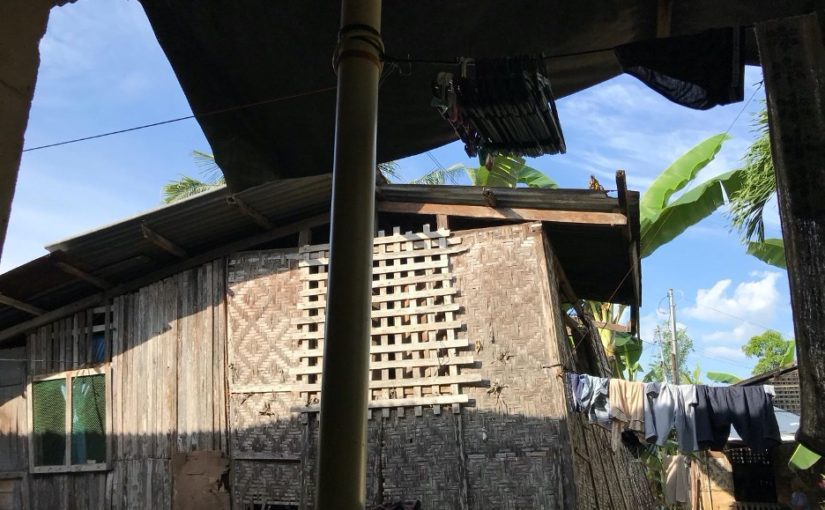By: Elise Verdooner
It is a humbling experience, visiting the houses of incremental builders. A narrow alleyway leads us through a winding maze between dwellings. Behind the cleanly painted and constructed facades the pathway is rocky, covered with rebar and sprinkled with decomposing trash and unused belongings. Houses, for lack of a better word, are pushed up against one another, collectively using structural elements such as beams or random poles to hang hammocks or lean shelves and belongings.
Walls are shared here, as people secure roofs and tarps to anything they can find. We pass a group of boys swinging from hammocks with a large radio perched between broken concrete blocks, looking over a half brick wall into an open kitchen with partial roof covering. A petite, stoic woman stands atop two steps in a doorway leading into one of the few enclosed structures around. This is our destination.
Seeing directly into and through people’s living areas, the question in my mind is: how do we, as academics and practitioners, define a house? My MGA Integration Lab team, partnering with Habitat for Humanity International’s Terwilliger Center for Innovation in Shelter, is conducting research in Peru and the Philippines to better understand low-income incremental builders: how they define value during the construction process and how the market best supports this segment to be more resilient in the face of natural disasters. To understand people’s experiences of building their homes incrementally over many years, we visited Angela’s* house.

Passing a doorway with no door and a kitchen with no ceiling, we approach the raised wooden bedroom and living room area. Taking off our shoes and climbing the three narrow steps into the home, our facilitator takes one step inside and immediately breaks through one of the old wooden floorboards covered by a fading and peeling plastic tarp floor covering. What would this permanent damage to the living room floor cost this family? The loaf of bread and food items we provide in compensation for their time certainly won’t cover the cost to repair the broken board, much less the rest of the floor, which looks like it needs it. I feel like we are walking on a trampoline with all the spring in the boards, and I’m careful in every footstep, recognizing the literal and metaphorical weight of our visit.
The overhead fan does little to circulate the hot air in the room, and there is no breeze coming through the open windows and doors. We sit along a hard wooden bench, sharing the space with a dusty flat screen television, a large speaker system, a small religious altar atop a shelf, and Angela’s bed. The house is 55 years old and has had no major repairs in that time. It feels every year of its age, and I am surprised it has lasted this long. As our facilitator begins the interview, I gaze at the underside of the corrugated tin roof discolored by age and weather, peeking through sparse wooden boards. I look around without judgment, merely observing, knowing in each of these observations there rests an insight into what this family needs: an opportunity to understand their priorities and help facilitate more sustainable and resilient construction practices.
These observations are cut short when ten minutes into our conversation we decide to discontinue the interview. Angela’s family does not fall into our target audience of incremental builders: they are not building or renovating their home and have no plans to do so in the immediate future. Given our limited time, we have to focus on low income households which nonetheless have enough money to incrementally build. We thank her for her time, and begin to step outside, but I pause for one more glance around the room: the decorative touches along the walls, the perfectly made bed and cleanly swept floors, and the way she talks about raising a family here, about owning her home, and about passing it on to her sons. Angela is proud of her home and the life she has created here.
We sometimes get so caught up in our research agenda, we miss the moment in front of us. It is easy to get swept up in the project—getting into the field, conducting interviews, analyzing data, meeting with stakeholders, presenting findings—and at times I forget to be fully present.
Before I can gather my thoughts, I’m on the flight back home, flipping through field notes, attempting to make sense of my quickly fading memories of sitting with Angela and others I met in the Philippines. As I look out the window, the landscape fades below me, and I am acutely aware of the importance of remaining fully present to learn, observe, and reflect so that my understanding of the on-the-ground realities are further enhanced.

While our visit to Angela’s house did not reveal new information about how incremental builders make decisions around construction processes, it laid an important foundation in our research. The decision to renovate and build a house is about more than household economics; it’s about creating a home. And a home is more than timber and steel; it is an intergenerational investment in which people take pride. The transcripts from Angela’s interview will never show up in our analysis, but her story has left a lasting impression upon our team. During our short visit, Angela remains stoic; she is not the smiling type. But, as she looks across the room to her son, leaning against a wall, she describes with pride that it is her favorite part of the house–because her husband built this section of the wall by hand, with the support of her children.
* All names and identifying information have been changed to protect confidentiality.

